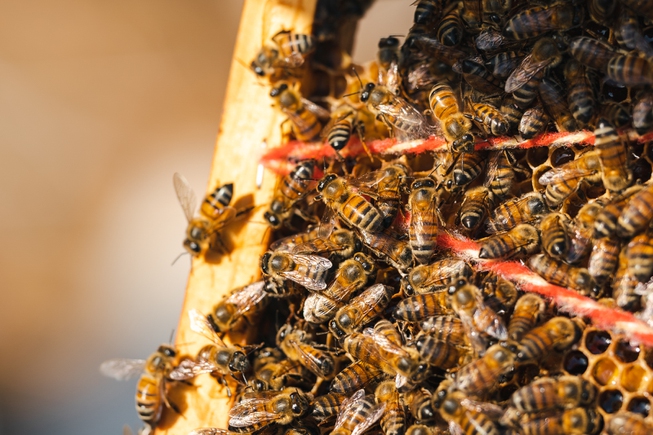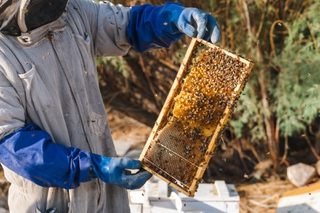
Beekeepers Dave Sharpless and Destry Myers demonstrated how they move and relocate their queen bees. With summer just around the corner, optimal temperature for the bees is about 95 degrees, any hotter and the bees will begin to exhibit stress have difficultly of surviving. Tuesday, June 6, 2023. Brian Ramos
Tuesday, June 13, 2023 | 2 a.m.
Beekeeper Dave Sharpless went to check on one of his beehives during this June 2019 day in Henderson only to find empty, melted hives.
The days of triple-degree heat during the summer months in Southern Nevada are extreme enough to drive some bee colonies from their hives, leaving behind a melted, sticky mess, he said.
Fall and winter are typically the most precarious time for hives, according to the United States Department of Agriculture, but Sharpless said comparably milder winters in the region are easier for them to get through. The real danger is summer heat even if bees have plenty of water and food.
“We lose more hives in the summer, it’s so extreme,” Sharpless said.
Sharpless has been keeping bees for 10 years and running the bee removal company LV Bees for six years. Instead of exterminating bees, he and partner Destry Myers move hives from customers’ properties to wooden structures in one of several Henderson fields, where he cares for them.
The incident four years ago was the first time they noticed the empty hives.
Sharpless began narrowing down what had caused them to flee. Colony Collapse Disorder wasn’t to blame, because instead of leaving the queen and a handful of nurse bees the colonies had completely abandoned their hive.
If pesticides or illness were the cause, dead bees would have been left behind.
“For most of those hives, even in full sun, 112 degrees is not a problem,” Sharpless said. “When it gets to be 117, 118, that’s when they say, ‘Nah, we can’t handle it.’ The honey starts to drip down on them and they say ‘Forget it, we’re out of here.’”
The following summer, Sharpless provided a closer water source that should have met their cooling and drinking needs and laid down bee-safe fire ant traps, but the exact same thing happened.
It only stopped in 2021, when he topped all of his boxes with 1-inch slabs of insulation foam, cutting down the heat and providing some extra shade.
To make matters stranger, it only happened to his hives in Southern Nevada.
“I have hives out in Arizona, out in the open like this, that don’t need the panels,” he said. “You’d think Northern Arizona gets just as hot as here. I have land in Moapa, and I don’t cover those either.”
Bees aren’t unequipped to deal with heat. In summer, they regulate the temperature inside their hives by collecting water, spreading droplets throughout the hive and fanning them with their wings to air condition the structures, he said.
Allen Gibbs, a life sciences professor and insect physiology expert at UNLV, said desert bee varieties should know how to weather the hottest temperatures. Some fly around with body temperatures of more than 120 degrees, he said.
“For the native bees, these are conditions they’re used to,” Gibbs said. “It’s kind of warm here for honeybees, but (native ones) do OK.”
He said the decades-long drought plaguing the area is a bigger problem for Southern Nevada bees than the heat itself.
“The hotter it gets, the faster they lose water,” he said. “That’s true for any insect.”
For Sharpless, business picks up fast in March and stays busy until the end of June. April and May are the busiest because colonies are growing their numbers and new swarms are splitting off to start their own colonies.
“I get calls two times a day from people like that. ‘I’ve got them under my composting!’ ‘I’ve got them under my shed!’ ‘I’ve got them in my roof,’” Sharpless said. “I’m like yeah, you’re not the only one. We’re booked.”
Sharpless said wild bees typically have a sense for where to build their hives to escape the heat, even in early spring. They’ll seek shade and enclosed spaces like irrigation valve boxes and any gaps inside unsuspecting Nevadans’ walls.
One recent customer, a woman who’d never encountered a hive in her 13 years in Las Vegas, realized a colony had made a home not only on, but in, the decking under her balcony, he said.
Their queen found her way into the interior wall through a hole left over from a speaker installation and the whole colony followed, making themselves cozy in the shaded, enclosed, insulated space.
Sharpless and Myers captured the colony and moved them to a box in the Henderson field.
Las Vegas isn’t the lone area of bee meltdowns as the earth’s temperature continues to rise.
In Australia, homeowners found honey leaking out of her wall and pooling onto the floor, according to 2020 report from ABC Radio in Perth. The homeowners found a melting hive weighing about 220 pounds inside an enclosed, unused chimney.
A Canadian bee researcher also in 2020 raised the alarm after discovering huge numbers of drones, or male honey bees, died of shock from heat stress.

